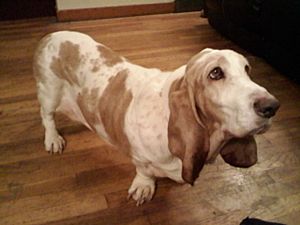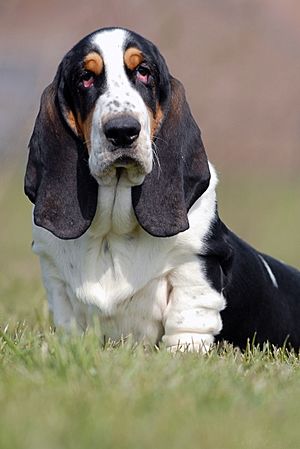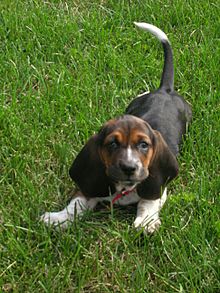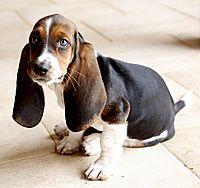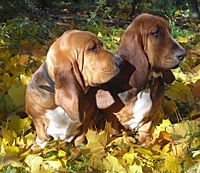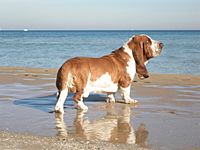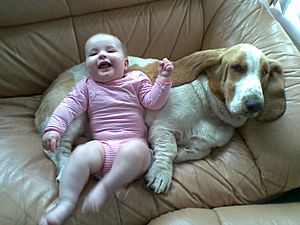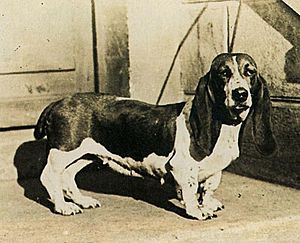Basset Hound facts for kids
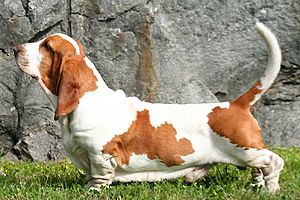
Tan and white Basset Hound
|
|||||||||||||||||||||||||||||||||
| Origin | France | ||||||||||||||||||||||||||||||||
|---|---|---|---|---|---|---|---|---|---|---|---|---|---|---|---|---|---|---|---|---|---|---|---|---|---|---|---|---|---|---|---|---|---|
|
|||||||||||||||||||||||||||||||||
| Domestic dog (Canis lupus familiaris) | |||||||||||||||||||||||||||||||||
The Basset Hound is a short-legged dog from the hound family. These dogs are famous for their amazing sense of smell. They use it to track animals like rabbits when hunting. Their sense of smell is so good, it's only beaten by the Bloodhound.
The name Basset comes from French words that mean "rather low." This makes sense because of their short legs!
Basset Hounds usually have coats that are brown, black, or white, and they often have spots. Sometimes, they can be other colors too. Basset Hounds have been around since the 1800s. They are thought to be related to a dog called the Basset d'Artois. Basset Hounds are about 30–38 centimetres (12–15 in) tall and can weigh up to 30 kilograms (66 lb).
Contents
About Basset Hounds
What They Look Like
Basset Hounds are sturdy dogs with short legs and long bodies. They have curved tails that they hold high over their backs. An adult Basset Hound usually weighs between 20 and 35 kilograms (44 and 77 lb). For their size, they have heavier bones than almost any other dog breed.
Like their relatives, the Bloodhounds, Basset Hounds have loose, hanging skin. This can make their faces look a little sad sometimes, which many people find charming! The loose skin around their neck is called a dewlap. Their long, floppy ears are the longest of any dog breed, along with the Bloodhound's. Both the dewlap and the long ears help them trap scents when they are tracking.
A Basset's neck is wider than its head. This, along with the loose skin, means that flat collars can easily slip off. The loose skin also creates the Basset's unique facial wrinkles. Their skull has a large nose, which is why their sense of smell is so powerful. It's second only to the Bloodhound in how well it can smell things.
Their Coat
A Basset Hound's coat is medium-short, smooth, and a bit stiff. They shed their fur often.
Basset Hounds can come in many different colors that are common for hounds. No one color is better than another. Many Bassets have a clear white stripe on their face, called a blaze. They also often have a white tip on their tail. This white tip was helpful for hunters to spot their dogs when they were tracking through thick bushes.
The Basset Hound's coat naturally produces oil. This gives them a special "hound scent" that is normal for the breed.
Their Personality
Basset Hounds are known for being friendly, outgoing, and playful dogs. They usually get along very well with children and other pets.
Basset Hound Health
Ears
Basset Hounds have very large, floppy ears. These ears hang down and don't allow much air to get inside. This can lead to ear infections or ear mites if their ears are not kept clean and dry.
Short Legs
Basset Hounds are naturally short because of a genetic condition called osteochondrodysplasia. This means their bones and cartilage grow in an unusual way. This type of dwarfism is also known as achondroplasia. Basset Hounds, Dachshunds, and Bulldogs are some dog breeds that have this condition. This bone growth can sometimes lead to elbow problems, which might cause arthritis in their elbow joints.
Other Health Concerns
Besides ear problems, Basset Hounds can sometimes have eye issues. Because their eyes are a bit droopy, dirt can collect under the eyeball. This area can also get clogged with mucus. Basset Hounds are also prone to yeast infections in the skin folds around their mouths. This happens because drool can collect there and not dry out completely.
How Long They Live
Basset Hounds usually live for about 10 to 12 years. This is a typical lifespan for purebred dogs and for dogs of a similar size.
Basset Hound History
Short-legged hunting dogs have been around for a very long time. Some of the oldest pictures of them come from ancient Egypt. Even mummified remains of short-legged dogs have been found in Egypt! Scent hounds were also used for hunting in Ancient Greece and Ancient Rome.
The modern Basset Hound was first bred in France. They were developed to hunt small animals like rabbits and hares. France is famous for creating many different types of scent hounds. Even today, it's not uncommon to see people hunting with a pack of Basset Hounds in France and the UK.
St Hubert's Hound
The Basset type of dog started in France. They are believed to be descendants of hounds that belonged to St Hubert of Belgium in the 6th century. These hounds were bred at a monastery and eventually became known as the St Hubert's Hound around 1000 AD. St Hubert's original hounds came from the Laconian Hound, which was a type of dog from ancient Greece. These scent hounds were described as large, slow, short-legged dogs with a deep bark. They were known for never giving up on a scent until they found their prey.
In France
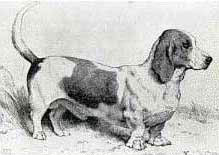
The first time a "basset" dog was mentioned in writing was in a hunting book from 1585. The dogs in this book were used to hunt foxes and badgers. It's thought that the Basset type came from a natural change in litters of Norman Staghounds, which were also related to the St Hubert's Hound.
Before the French Revolution around 1789, hunting from horseback was mostly for kings and rich families. Because of this, short-legged dogs were very valuable for hunting on foot.
Basset-type hounds became very popular during the time of Emperor Napoleon III (from 1852 to 1870). In 1853, a famous sculptor named Emmanuel Fremiet showed bronze statues of Emperor Napoleon III's Basset Hounds at an art show in Paris. Ten years later, in 1863, Basset Hounds gained international attention at the first dog show held in Paris.
Controlled breeding of the short-haired Basset began in France in 1870. From the existing Bassets, two main types were developed. One type had straight front legs and was known as the Chien d'Artois. The other type had crooked front legs and was called the Basset Normand. These two types were then bred together to create the original Basset Artésien Normand.
In England
French Basset Hounds started being brought into England as early as the 1870s. By the 1880s, some of these dogs were bred to be heavier. Everett Millais, who is seen as the founder of the modern Basset Hound, bred one of these dogs with a Bloodhound in the 1890s. This was done to create a heavier Basset in England. The first official rules for what is now known as the Basset Hound breed were made in Great Britain at the end of the 19th century. These rules were updated in 2010.
Hunting with Bassets
The Basset Hound was bred for hunting. Their excellent nose and short height make them perfect for hunting small game on foot. A special type of Basset Hound, bred just for hunting, was recognized in 1959. These hunting Bassets are a bit straighter and longer in the leg, and they have shorter ears.
See also
 In Spanish: Basset hound para niños
In Spanish: Basset hound para niños


